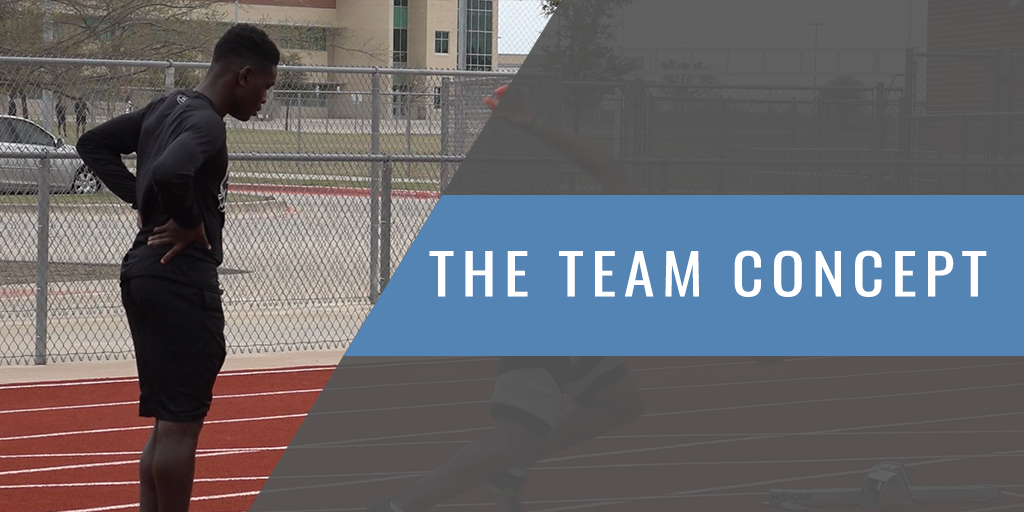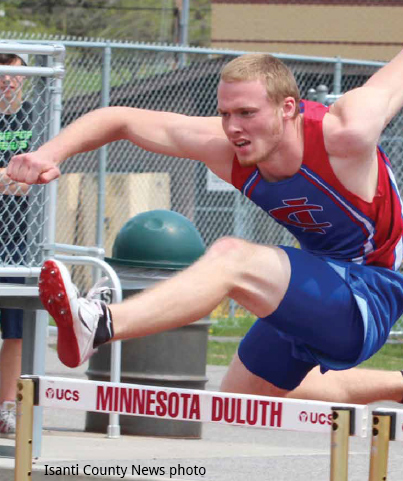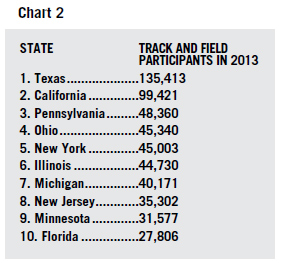| By: Kent Viesselman
Originally Published in Techniques Magazine, Provided by: USTFCCCA
I think many track and field coaches are missing out on another aspect of sport, and I believe it is affecting our sport adversely. I am talking about the possibility that high school track may not be an individual sport. In fact, I would argue that most great high school track and field coaches teach it as a team sport, and that is one of the main "secrets" to their success. What do I mean by coaching track and field as a team sport? The main objective or priority is team success and is not limited to the individual success of gifted individuals. It's about being concerned with the good of the group as a whole. So how is this beneficial? A team approach can address or eliminates common frustrations associated with coaching track and field. A. Lack of Leadership, Commitment Wherever I have coached, initially the student-athletes I have worked with have a problem with being committed to track and field. Sure, you will have a handful of kids to whom commitment comes easy but by and large the masses struggle with this concept. This is not a criticism. It is reality. How do you address this? You need to instill in your team that they are a part of something larger than themselves. In a team concept, when they aren't committed as individuals, they are hurting their teammates. Over time they start policing each other and taking care of issues without you even getting involved. As a result, your athletes start taking ownership of their team. Your leaders make sure team members are present at practice and meets. Gradually, effort in individual workouts improves as well. Commitment and working hard isn't about them anymore, it's about not letting down their teammates and friends. My Dad, a Minnesota track coaching veteran of 50 years, said something very wise to me when I started coaching. He said that there is no such thing as a lack of leadership. There is always someone leading, the question is whether it is positive or negative leadership. A team approach allows for more opportunities for positive leadership and positive leaders. B. Lack of Exposure (This is a Process) Many non-track people think of track as a minor sport. I am not exactly sure what that means, but the evidence of this is they treat track and field like it is inferior to sports that they believe are either more prestigious or more important in their eyes. This can have an insidious impact on your program. When track and field is taught as a team sport, focusing more on all of your athlete's improvement instead of a select few, a funny thing happens. It's like bugs being drawn to a light. Students start talking about how they feel important in your program. They talk about how everyone gets to "play." The effect is profound because this notion of everyone truly having a place on the team is foreign to most sports currently in our culture...even those that we consider "team" sports. The reason for this is because track is one of the very few sports that for most contests, everyone can participate. There is no starting 5 or starting 11. In essence, everyone "starts." The impact on parents is predictable. People like to support something in which kids feel empowered and important. A natural outgrowth of this is an increase in participation in track and field. This does not go unnoticed in a community, and in time much of the lack of exposure and respect in your community will wane or fade away to a large extent. A Team Approach Reinforces the Strengths Unique to Track and Field What are the strengths of track and field? While this is not an exhaustive list, I believe for our discussion it is sufficient. A. Observable performance improvement (individual time, team/relay time, individual place, etc.) By coaching track as a team sport, you add letters C, D, E and strengthen letter F in the above list. So instead of 4 ways to "win" in track, you have doubled that to 8 ways to find success. That is 100 percent increase in possible strengths. That is a substantial gain and not one that should be dismissed. A Team Approach Helps Your Outstanding Individuals A. A team approach forces you and your staff to do a more extensive evaluation of the student-athletes in your program. B. A team approach allows your individuals to perform better in "big" meets. A Team Approach Increases Participation Numbers. The year before I became head coach of girls track and field, there were a little over 30 girls out for the sport in our high school. The last year I was the girls head coach in our high school we had approximately 110 girls participating. Eight years ago, I took over the boys program and was coach of both boys and girls at our school for five years. There were 55 boys out for track and field in our school the year before I started as head boys coach. This past year, we had approximately 115 boys participate. Three years ago, my last year as head boys and girls track coach, we had over student athletes out for track and field. We outgrew our ability to have one head coach for both genders. Maybe its coincidence, but I firmly believe the team approach had a huge impact on our participation numbers. There is little doubt that the kids already on the team helped recruit others into the program. Because everyone gets to play (see strengths of track and field) and it's a positive experience, your athletes want their friends to have a good experience as well. Countless times I have had a track athlete come up to me and say, "Coach, I have a friend that I know would be good at the such and such. I know that is an event we could get better at." I used to recruit athletes that weren't in another spring sport quite a bit. Honestly, I recruit only a handful of kids now. Most of the new team members choose to come out because a friend or acquaintance on the team talked to them about their experience in track. A Team Approach Forces You to Have a More Cohesive Coaching Staff.
A team philosophy forces you and your staff have to communicate more often. By having a team philosophy, I have to communicate more frequently and more intentionally to make sure that our team is as strong as possible in all events and that everyone on the coaching staff is on the same page. I am fortunate enough to have a great coaching staff but a team approach does tend to force us talk more frequently and more constructively about the athletes on our team. A team approach also forces your assistants to be more observant about potential track athletes and communicate that to you. This past year, we posted depth charts of performances. To do this, I had to check with our assistants often for accuracy and sometimes clarification. Our entire staff had a very good idea of how all athletes performed in all events. It also helped highlight a couple of the strengths of track and field I highlighted earlier in this conversation. The objectivity of who "starts" in track and field and the potential for easily documented improved individual performance is highlighted in such an exercise. The depth chart was initiated because of our philosophy, but ended up helping in unintended ways. How Does This Philosophy Go Beyond Individual Track Programs? At the beginning of this article I alluded to the unique situation we have in Minnesota with respect to team track and field. It all started almost 30 years ago in Minnesota. A handful of track coaches were confronted with the reality that a couple of athletes had just won a "team" championship at the Minnesota State Track and Field Meet. As a result, several track coaches started meeting to determine if they could devise a way to measure total team strength and award a TRUE team track and field champion. In 1987, Minnesota held its first True Team Track and Field Championships and crowned state team track and field champions. This Championship attempts to gauge overall team strength and therefore honor a "TRUE" team champion. This is accomplished by scoring all individuals that participate in the track meet. For larger schools, this means scoring three individuals from each school in each individual event as well as one relay team per relay event. For smaller schools, two individuals per individual event are scored and one relay team per relay event. (To see more specific information on this topic, I recommend that you visit the Minnesota State High School Track Coaches Association at http://mshsca.org/track/index.htm. ) The championships are run completely by Minnesota High school track and field coaches. Minnesota is currently the only state in the United States that hosts a standalone Team Championship in track and field. What has been the impact of such a state-wide philosophy? In 1987, the year the Minnesota True Team Track and Field Championships started, track and field ranked 3rd in total participation in the state at approximately 15, 570 individuals behind football (19, 617 individuals) and boys/girls basketball (18, 348). In 2013, track and field in Minnesota ranked 1st in total participation in the state at approximately 31, 577 individuals. Football was 2nd (26, 563 individuals) and boys/girls baseball and softball was 3rd (25, 225 individuals) and boys/girls basketball was 4th (25, 104 individuals) for participation in the state of Minnesota. In terms of participation growth over that span, track and field participant numbers grew by 100. 5 percent, baseball/softball grew by 68. 5 percent, and basketball and football grew at rates of 36.8 percent and 35 percent, respectively. In other words, in the span of years in which the true team track and field championships was introduced track and field has become the No. 1 sport in participation of individuals in Minnesota and the growth in participation numbers for track and field has far surpassed any of the other "established" team sports. I believe the growth percentage is the real key to this conversation. Growth that dramatic can't simply be attributed to population increases due to the dramatic difference in growth percentage relative to the other established "team" sports. It also bears mentioning that track and field's popularity in Minnesota has not been a one year phenomena. Five of the last six years, track and field has been the most popular sport by participation in the state of Minnesota. See Chart 1. So, it's a nice little story. The number of students participating in track and field has increased quite a bit in the state of Minnesota. What if it is a little bit more dramatic than that? It turns out that Minnesota is in the top 10 states in the U. S. for students participating in track and field. Here are the numbers according to the NFHS for 2013. See Chart 2.
However, these numbers do not tell the complete story. They don't take into account population differences between states. It would seem obvious, that a state with a larger population should have more sports participants. According to the U. S. Census Bureau, only one of these states is not in the top 11 states for overall population and it's Minnesota at No. 21. The table below takes into account these two items as well as estimations of the high school student athlete population available to each state based upon numbers available from the U.S. Census Bureau. Some states have younger populations and the U. S. Census Bureau has that data. See Chart 3. According to the numbers, Minnesota has the largest percentage participation of all of the states in the top 10 track and field participation rates at 10. 5 percent. In fact, none of the states in the top 30 states with respect to population that offer baseball and softball during the same season as track and field even approach 10 percent participation of their "available" athletes for track and field participation. Something different is taking place in Minnesota; something very positive with respect to track and field. So What Does All of this Mean? On both a program level and at a state level, a team philosophy seems to be a very positive thing for high school track and field. Whether talking about increasing participation numbers, helping your outstanding individuals perform at a higher level, or allowing kids in your program to feel valued and a part of something larger than themselves, the benefits seem to be obvious. I want to offer one other item to consider. I believe above all else, coaches are teachers. We are teaching students about something larger than sport. Wins and losses are important but when a student leaves your program what do you want them to take with them? What do you deem important? Is it more important for them to discover that they have the ability to be a 20' long jumper or for students and adults to learn how to work together, put aside their own wants, and realize what it is to be a positive, contributing member of a team. It has been my experience that there are very few adults that understand what it truly means to be a good teammate. As coaches and teachers, there may be no greater calling than to help the students under our charge to realize that they are not the main character in the story. I would encourage those of you that think of high school track and field as an individual sport to think about making a shift in your coaching paradigm. It will benefit your program greatly, but more importantly, it will benefit the young adults placed in your care.
SOURCES Kent Viesselman is the Head Boys Track and Field Coach at Cambridge-Isanti High School in MN. He has also served as president of the MN Track Coaches Association, Chair of the MN Clinic committee and is a member of the MN True Team Track and Field Committee.
|




 I still remember it vividly. I was at my first USTFCCCA convention in Orlando, Florida, listening to USTFCCCA CEO Sam Seemes discussing the state of Track and Field in the United States. He used words such as "crisis" and "crossroads," and it made me nervous. Was it possible that I was missing something, or was it even worse than that? As I walked around for the remainder of the convention, I started to realize that my little world was not the norm, and at some point, if I truly cared about track and field, I might have to get out of my comfort zone and share with a larger audience. So, here we are.
I still remember it vividly. I was at my first USTFCCCA convention in Orlando, Florida, listening to USTFCCCA CEO Sam Seemes discussing the state of Track and Field in the United States. He used words such as "crisis" and "crossroads," and it made me nervous. Was it possible that I was missing something, or was it even worse than that? As I walked around for the remainder of the convention, I started to realize that my little world was not the norm, and at some point, if I truly cared about track and field, I might have to get out of my comfort zone and share with a larger audience. So, here we are.





